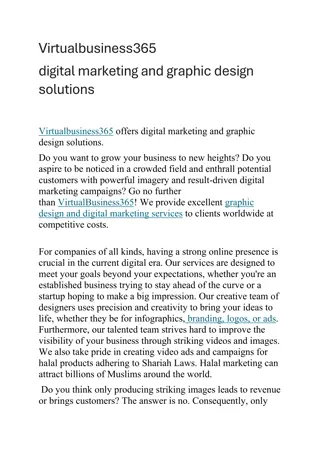
Influencer Marketing for the Fashion Industry Cultivating Connections in a Crowded Closet
The fashion industry has always thrived on creating a captivating narrative. But in today's digital age, the runway has extended far beyond the physical realm. Social media platforms like Instagram and TikTok have birthed a new breed of fashion story
Download Presentation

Please find below an Image/Link to download the presentation.
The content on the website is provided AS IS for your information and personal use only. It may not be sold, licensed, or shared on other websites without obtaining consent from the author. If you encounter any issues during the download, it is possible that the publisher has removed the file from their server.
You are allowed to download the files provided on this website for personal or commercial use, subject to the condition that they are used lawfully. All files are the property of their respective owners.
The content on the website is provided AS IS for your information and personal use only. It may not be sold, licensed, or shared on other websites without obtaining consent from the author.
E N D
Presentation Transcript
Influencer Marketing for the Fashion Industry: Cultivating Connections in a Crowded Closet The fashion industry has always thrived on creating a captivating narrative. But in today's digital age, the runway has extended far beyond the physical realm. Social media platforms like Instagram and TikTok have birthed a new breed of fashion storytellers: influencers. Influencer marketing for the fashion industry has become a powerful tool, leveraging the trust and reach of these online personalities to connect with potential customers in an authentic and engaging way. This article delves into the world of influencer marketing for fashion brands, exploring its benefits, navigating its complexities, and offering strategies for building successful partnerships. Whether you're a seasoned marketing professional or a budding entrepreneur, this guide will equip you to harness the power of influencers and elevate your brand in the ever-evolving fashion landscape. The Rise of the Influencer: Why They Matter Gone are the days of relying solely on glossy magazines and celebrity endorsements. Today's consumers crave authenticity and relatable voices. Influencers, with their dedicated followings and genuine online personas, have emerged as trusted sources of inspiration. Here's what makes them such a powerful force in the fashion industry:
Building Trust and Credibility: Influencers cultivate relationships with their audience through consistent content creation and interaction. This fosters a sense of trust that traditional advertising often struggles to achieve. When an influencer promotes a fashion brand or product, it comes across as a genuine recommendation rather than a forced advertisement. Hyper-Targeted Reach: The beauty of influencer marketing lies in its ability to target specific demographics and niche audiences. Fashion brands can collaborate with influencers who cater to their ideal customer base, ensuring their message reaches the right eyes. Visual Storytelling: Fashion is a visual medium, and influencers excel at creating captivating content that showcases products in an engaging way. From stylish flatlays to inspiring outfit reels, influencers can bring a
brand's vision to life and ignite excitement around new collections. Driving Engagement and Conversions: Influencer marketing goes beyond brand awareness. Effective campaigns can drive website traffic, boost online sales, and generate user-generated content that further amplifies the message. Navigating the Influencer Landscape: Finding the Right Fit The influencer marketing landscape is vast and ever- changing. With a plethora of influencers across diverse platforms, finding the right fit for your brand is crucial. Here are some key considerations: Audience Demographics: Who are you trying to reach? Identify your target audience's age, interests, and online behavior. Then, find influencers whose followers align with these demographics. Content Style and Brand Alignment: Does the influencer's content style resonate with your brand's image and messaging? Look for influencers who create content that complements your brand's aesthetic and voice. Engagement Rate: Popularity isn't everything. Focus on influencers with a high level of engagement, measured by likes, comments, and shares. A smaller, highly engaged audience can be more impactful than a massive, passive following. Authenticity and Transparency: Consumers are savvy and can easily spot inauthentic partnerships. Look for influencers who genuinely connect with your brand and its values. Encourage transparency in their sponsored content, ensuring clear disclosure of collaborations.
Building Successful Influencer Partnerships: 1. Define Your Goals and Objectives Before diving headfirst, establish clear goals for your influencer marketing campaign. Do you seek brand awareness, increased website traffic, or a boost in sales? Defining your goals ensures your chosen influencer aligns with your desired outcomes. 2. Craft a Compelling Brief Provide the influencer with a clear and detailed brief outlining your brand's story, target audience, campaign objectives, and desired content style. This ensures everyone is on the same page and fosters a collaborative environment. 3. Give Creative Freedom
While guidance is important, allowing the influencer creative freedom is key. Their unique voice and style are what resonate with their audience. Trust their expertise and focus on brand alignment rather than micromanaging the content creation process. 4. Prioritize Measurement and Tracking Track the performance of your influencer marketing campaign using relevant metrics. Analyze engagement rates, website traffic generated, and coupon code conversions. Use this data to refine your strategy and identify which partnerships are driving the most impactful results. 5. Foster Long-Term Relationships Think beyond one-off collaborations. Building long-term relationships with a few key influencers can be more impactful than a string of short-lived partnerships. Cultivate a collaborative and supportive environment, creating a mutually beneficial relationship. Beyond the Followers: Exploring the Influencer Ecosystem The influencer landscape extends beyond Instagram stars with millions of followers. Here are some emerging trends and niche areas to consider: Micro-Influencers: These individuals have smaller yet highly engaged followings. Partnering with micro- influencers allows for targeted campaigns reaching a specific audience segment and often fosters a stronger sense of community and trust. Nano-Influencers: These are everyday people with niche followings built around specific interests or styles.
Collaborations with nano-influencers can feel incredibly authentic and relatable, particularly for smaller brands or those targeting a very specific aesthetic. Long-Form Content Creators: Fashion bloggers and YouTubers who create in-depth reviews, tutorials, or haul videos can offer a deeper dive into your products, fostering trust and purchase decisions. Social Commerce Platforms: Platforms like TikTok and Instagram Shopping allow for seamless integration of influencer content with direct purchasing options. Leveraging these features can drive immediate conversions and capitalize on the excitement generated by influencer marketing. Employee Advocacy: Don't underestimate the power of your own team. Encourage brand advocates within your company to share their genuine experiences with your products on their social media platforms. This fosters authenticity and leverages the trust employees have built with their own networks. The Future of Influencer Marketing: Embracing Transparency and Authenticity
Influencer marketing is a dynamic field, constantly evolving alongside consumer behavior and social media trends. Looking ahead, here are some key points to consider: Focus on Transparency: Regulations around influencer marketing are becoming increasingly stringent. Ensure clear disclosure of sponsored content and avoid misleading partnerships. Consumers appreciate brands that prioritize transparency and authenticity. Data-Driven Decisions: Data analytics will play a critical role in measuring the success of influencer marketing campaigns. Use data to identify high-performing partnerships, refine your strategy, and optimize your return on investment. The Rise of Influencer Marketing Platforms: Platforms that connect brands with influencers and streamline the collaboration process are becoming increasingly popular. These platforms can be valuable tools for managing
influencer relationships and tracking campaign performance. The Power of Community Building: Successful influencer marketing goes beyond individual campaigns. Focus on fostering a community around your brand by encouraging interaction between influencers and consumers. This fosters brand loyalty and creates a powerful network of advocates. Conclusion: A Strategic Approach to Fashion Influencer Marketing Influencer marketing, when done strategically, can be a powerful tool for fashion brands of all sizes. By understanding your target audience, building authentic partnerships with the right influencers, and embracing transparency, you can leverage the power of social media to elevate your brand, engage your audience, and drive sales. The fashion industry is a canvas brimming with creativity and storytelling potential. By harnessing the influence of social media personalities and cultivating genuine connections with consumers, fashion brands can navigate the ever-evolving digital landscape and ensure their story continues to resonate in the crowded closet of the modern consumer.






















